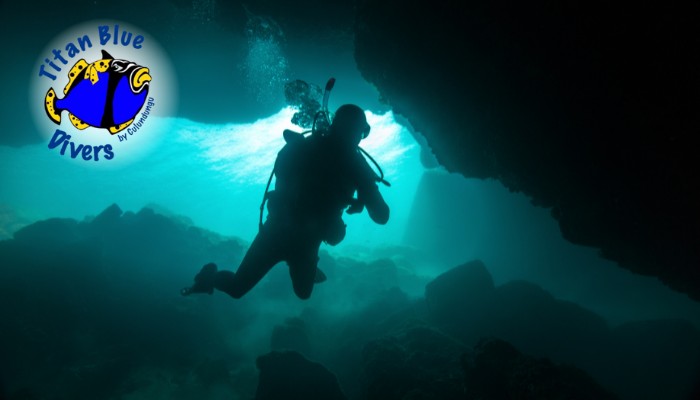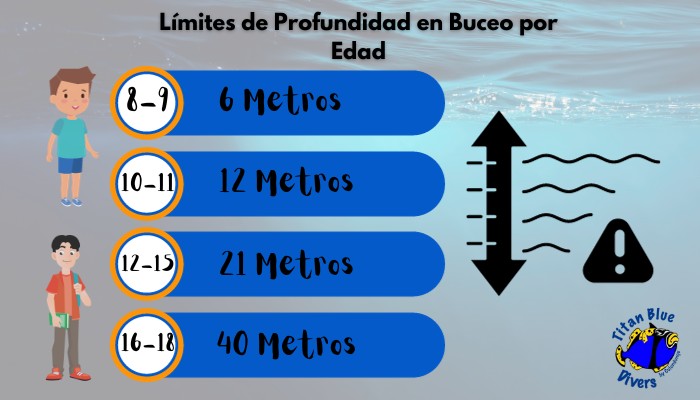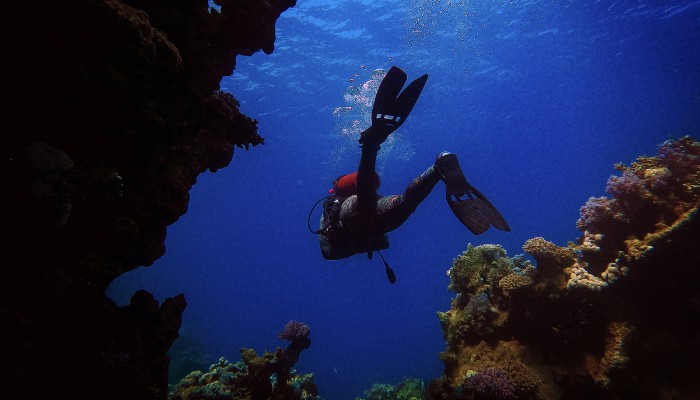
What is the Maximum Diving Depth and How to Reach It?
What is the maximum limit to which a human being can descend into the depths of the ocean? Reaching the maximum depth in diving represents a feat for many. The intrigue of what kind of lives we can find, how much we can resist and how much of our past we can discover in a single dive can be simply fascinating.
But not everything is black and white. As we dive deeper and deeper, we face environmental and physiological challenges that require more than a level of expertise: They require discipline and responsibility.
And there is more.
What does it take to reach these unknown depths? We tell you in this post everything a true adventurous diver should know about challenging the abysses Join us!
How Deep Can We Dive Safely When Diving?
The first thing you should know is that in Spain, the practice of recreational diving is limited to a maximum of 40 meters according to the Royal Decree 550/2020, published on June 26th.
In this mode you can use only air or nitrox. In addition, you must have direct access to the surface at all times and the minimum dive unit is a pair of divers.
On the other hand, in technical diving the depth limits are set by your level of certification and knowledge (also influenced by the limits set by your dive insurance).
But there's more. The maximum depth you can dive to will also be determined by whether you dive with or without equipment.
Limits with Equipment
If you do not wear essential breathing apparatus you would be practicing what is known as free diving, apnea or freediving.
The limits in this modality are usually set at 6 meters. However, with a lot of discipline and effort it is possible to reach 12 meters.
Of course, this discipline involves great challenges, as you will have to deal with the lack of oxygen and atmospheric pressure.
Limits without Equipment
In this case the maximum diving depth is higher. However, the limits are established by the laws of each country. In Spain it is regulated by the BOE.
Royal Decree 550/200 establishes that:
«En el buceo profesional en técnica de suministro en superficie la profundidad máxima será:
- With air or nitrox up to 50 meters deep.
- Con mezclas ternarias trimix y binarias heliox, hasta 75 metros de profundidad, con las tablas de descompresión adecuadas.»
It is also important to note that any dive deeper than 50 meters must be done with an access and recovery platform with the following characteristics:
- It must have a capacity to accommodate (minimum) 2 divers.
- It must have a protective device over the head and handles.
- It should be designed to prevent twisting and balancing in order to prevent the diver from falling.
Are there Age Depth Limits?
Yes, this is another factor that limits the maximum diving depth.
Below is a chart showing the age range and how deep they can dive:

What Other Factors Limit Depth?
Deep diving is an exciting feat, but it is fraught with challenges and limitations that must be understood and overcome by any daring diver.
In addition to the maximum depths that can be reached, there are other factors that limit our underwater explorations. We tell you what they are:
Water Pressure
Water pressure is a monumental challenge for divers! As you descend into the ocean, the pressure increases significantly.
At a depth of 10 meters, the pressure is twice that at the surface, and at 100 meters, it is approximately 11 times greater.
At such depths, human bodies and equipment must withstand tremendous forces. That's why divers use rugged wetsuits and equipment designed to withstand this pressure.
2. Effects of Nitrogen Narcosis
La narcosis por nitrógeno, a menudo llamada «ebriedad de las profundidades,» es otro factor crítico a considerar.
As you dive deeper, the nitrogen in the air you breathe underwater can affect your mind.
Symptoms include euphoria, disorientation and a decreased ability to make rational decisions. To counteract this, deep divers often use special gas mixtures with less nitrogen.
Temperature
Underwater temperatures are also one of the most important factors.
As you go deeper, the water temperature tends to decrease. This can cause hypothermia if you are not properly protected.
Advanced drysuits and wetsuits are essential for maintaining proper body temperature in cold and extremely deep water.
4. Oxygen Availability
Oxygen is vital for human survival, and its availability decreases as you dive deeper.
At extreme depths, the oxygen content in the air becomes insufficient. For this reason, divers use gas mixtures containing less oxygen and more helium or hydrogen, as needed.
5. Complications of Decompression
Decompression is a critical process for divers who have been at great depths for an extended period of time.
As they ascend to the surface, they must do so in a controlled manner to allow the inert gases to gradually release from their tissues and avoid decompression sickness.
Improper calculation or too rapid ascent can have serious consequences. Here we tell you all about decompression.
How can I reach the maximum depth in diving?
There is one very important factor that you should not lose sight of: the deeper you dive, the less time you spend at the bottom, why? Well, it's all due to the no-decompression limits.
For example, at 18 meters we can stay around 55 minutes without having to decompress. However, at a depth of 40 meters we can only stay 8 minutes without having to decompress. Therefore, the deeper we go, the less time we will have to enjoy the environment safely.
Now, with this clarified, there is another important point: How deep can you go in your dives?
The answer is a cliché: It depends. 😅
Yes, it depends on which of the diving certifications you have achieved, as in Spain there are 3 depth levels that correspond to 3 levels of certification:
Open Water Diver: 18 Meters
In this first level of certification you can dive independently, because the one that precedes it is the Scuba Diver with which you can dive down to 12 meters, but always in the company of a professional.
However, as mentioned before, the time you spend at the bottom is determined by the depth you reach due to the no-decompression limits.
This no-decompression time limit is established by the FEDAS, PADI and SSI tables.
This is what each dictates for a depth of 18 meters as an Open Water Diver:
- FEDAS: 60 minutes
- PADI: 55 minutes
- SSI: 50 minutes
Advanced Diver: 30 Meters
In this case, at a depth of 30 meters you will have 25 minutes without having to decompress, according to FEDAS.
In the case of PADI and SSI they set it at 20 minutes.
Deep Diving Specialty: 40 Meters
This is the maximum depth limit for recreational diving in Spain, as at this point there is a great loss of light and significant adverse conditions.
The no-decompression time limit here continues to drop, standing at 10 minutes according to the FEDAS table; 8 minutes for PADI and 5 minutes according to SSI.
This bottom time is especially small because it also considers how long the ascent and descent will take.

World Records of Maximum Depth in Scuba Diving
1. Ahmed Gabr - Technical Diving
Ahmed Gabr, an Egyptian diver, made history by descending to 332.4 meters in the Red Sea. Although it took him 12 minutes to reach his target depth, his ascent required 14 hours with respective decompression stops. He used advanced technical equipment and meticulous planning for this unparalleled dive.
William Trubridge - Apnea
William Trubridge, a New Zealander with a passion for free diving, is known for his incredible feats in this discipline. He managed to reach a depth of 124 meters in apnea, while holding his breath for 4 minutes and 34 seconds. He set a new world record in this category.
3. Natalia Molchanova and Alexey Molchano - Dynamic freediving with fins
Both set remarkable records in this variant of freediving, with 101 and 128 meters of depth.
So much for our post about all the challenges of reaching the maximum depth in diving. We hope we have solved all your doubts.
Remember that if you want to explore the depths of Lanzarote with total security and maximum fun, in our diving center in Lanzarote we make it possible.
And if you are interested in diving deeper into this fascinating world, we also have for you the best diving courses that will allow you to conquer your dives like a professional.

